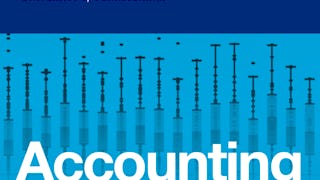In this course, you’ll explore how financial statement data and non-financial metrics can be linked to financial performance. Professors Rick Lambert and Chris Ittner of the Wharton School have designed this course to help you gain a practical understanding of how data is used to assess what drives financial performance and forecast future financial scenarios. You’ll learn more about the frameworks of financial reporting, income statements, and cash reporting, and apply different approaches to analyzing financial performance using real-life examples to see the concepts in action. By the end of this course, you’ll have honed your skills in understanding how financial data and non-financial data interact to forecast events and be able to determine the best financial strategy for your organization.



Financial Acumen for Non-Financial Managers
This course is part of multiple programs.


Instructors: Richard Lambert
42,842 already enrolled
Included with 
(955 reviews)
Details to know

Add to your LinkedIn profile
6 assignments
See how employees at top companies are mastering in-demand skills

Build your subject-matter expertise
- Learn new concepts from industry experts
- Gain a foundational understanding of a subject or tool
- Develop job-relevant skills with hands-on projects
- Earn a shareable career certificate


Earn a career certificate
Add this credential to your LinkedIn profile, resume, or CV
Share it on social media and in your performance review

There are 4 modules in this course
This module was designed to give you a foundational overview of financial reporting and income statements. You’ll identify and analyze balance sheet equations and its key components such as assets, liabilities, and shareholders’ equity. Through examining a sample real-world financial statement, you’ll learn how to calculate income, revenue, and expenses transactions, and see how the income statement is linked to changes in the balance sheet. By the end of this module, you’ll have a better understanding of the key components in financial reporting and learn how to craft an accurate income statement for your organization.
What's included
11 videos2 readings2 assignments
In this module, you’ll examine cash flow statements further, and take a closer look at methods of creating cash flow statements. Using your understanding of financial reporting, you’ll be able to classify different business activities into separate categories such as operating, investing, and financing activities. Through analyzing the real-world financial statement from the previous module, you’ll learn about both direct and indirect methods of creating cash flow statements. By the end of this module, you’ll be able to differentiate between various business activities and effectively utilize both direct and indirect methods of creating cash flow statements for your organization.
What's included
5 videos2 readings2 assignments
In this module, you’ll examine a systematic approach to ratio analysis and other common tools of financial statement analysis. You’ll develop an understanding of ratios and liquidity measures so you can accurately assess risk within your organization’s financial activities. You’ll discover different approaches to profitability measures such as Earnings Per Share (EPS), Return on Equity (ROE), and the Dupont Analysis. You will be able to match Return on Assets (ROA) to various types of companies and gain a better understanding of the drivers of ROA. Then, you’ll explore the concepts of sales revenue and different qualities of earnings. By the end of this module, you’ll understand the theoretical basis behind ratio analysis, and be able to employ different ratio analyses and accurately calculate profitability measures for your organization.
What's included
5 videos1 reading1 assignment
In this module, you’ll discover how to determine which non-financial performance measures predict financial results through asking these fundamental questions: Of the hundreds of non-financial measures, which are the key drivers of financial success? How do you rank or weight non-financial measures which don’t share a common denominator? And what performance targets are desirable? You’ll examine comprehensive examples of how companies have used accounting data to show how investments in non-financial dimensions pay off in the future and important organizational issues that commonly arise using these models. By the end of this module, you’ll know how predictive analytics can be used to determine what you should be measuring, how to weight different performance measures when trying to analyze potential financial results, how to make trade-offs between short-term and long-term objectives, and how to set performance targets for optimal financial performance.
What's included
7 videos1 reading1 assignment
Instructors

Offered by
Explore more from Business Essentials


Emory University


University of California, Irvine


University of Pennsylvania


University of Illinois Urbana-Champaign
Why people choose Coursera for their career




Learner reviews
955 reviews
- 5 stars
65.86%
- 4 stars
23.87%
- 3 stars
6.38%
- 2 stars
2.72%
- 1 star
1.15%
Showing 3 of 955
Reviewed on May 29, 2020
It is a good course and was helpful. The multiple choice questions were tough because it felt like there wasn't enough information toanswer them effectively.
Reviewed on Feb 10, 2022
Basic overview on Financial Analysis. Should bring in more healthcare related items and review healthcare financial statements and financial drivers
Reviewed on Jul 16, 2018
Level of Difficulty is good. Challenging at times to executives in firms who don't have much exposure to financial aspects of the firm. But grit will help you go through the course and complete it.
New to Business Essentials? Start here.

Open new doors with Coursera Plus
Unlimited access to 10,000+ world-class courses, hands-on projects, and job-ready certificate programs - all included in your subscription
Advance your career with an online degree
Earn a degree from world-class universities - 100% online
Join over 3,400 global companies that choose Coursera for Business
Upskill your employees to excel in the digital economy
Frequently asked questions
Access to lectures and assignments depends on your type of enrollment. If you take a course in audit mode, you will be able to see most course materials for free. To access graded assignments and to earn a Certificate, you will need to purchase the Certificate experience, during or after your audit. If you don't see the audit option:
The course may not offer an audit option. You can try a Free Trial instead, or apply for Financial Aid.
The course may offer 'Full Course, No Certificate' instead. This option lets you see all course materials, submit required assessments, and get a final grade. This also means that you will not be able to purchase a Certificate experience.
When you enroll in the course, you get access to all of the courses in the Specialization, and you earn a certificate when you complete the work. Your electronic Certificate will be added to your Accomplishments page - from there, you can print your Certificate or add it to your LinkedIn profile. If you only want to read and view the course content, you can audit the course for free.
If you subscribed, you get a 7-day free trial during which you can cancel at no penalty. After that, we don’t give refunds, but you can cancel your subscription at any time. See our full refund policy.
More questions
Financial aid available,

